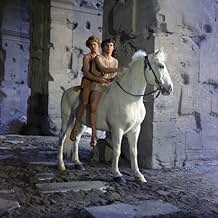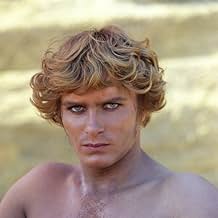A series of disjointed mythical tales set in first-century Rome.A series of disjointed mythical tales set in first-century Rome.A series of disjointed mythical tales set in first-century Rome.
- Nominated for 1 Oscar
- 5 wins & 8 nominations total
Mario Romagnoli
- Trimalcione
- (as Il Moro)
Danika La Loggia
- Scintilla
- (as Danica la Loggia)
Lucia Bosè
- La matrona
- (as Lucia Bosé)
Joseph Wheeler
- Il suicida
- (as Joseph Weelher)
George Eastman
- Minotauro
- (as Luigi Montefiori)
Featured reviews
...and because I had read "Satyricon" before I saw it I probably was less baffled by the movie than most people. Very little survives of the content of original story, a few longish bits and lots tiny fragments, sometimes as short as a sentence or a word. All disconnected from each... ...ning and end of Petronius' novel are missing, what we have left suddenly starts in the middle without any background or prelude. And each of the surviving bits is the same way, giving few, if any hints, of how our heroes got there from their last adventure, or how their current one will be resolved. Or even what their current crisis is. We can onl... ...bother making a film of from such a fragmentary source? Because Petronius is wickedly funny and has a gifted insight into human... ...participant in the decadence and depravity, yet judging and commenting on it at the... ...2000 years been read and translated... ...amorallity, but social standards always... ...Fellini captures the spirit not only of Imperial Rome but of... ...doesn't make sense, so like you do in the original, you have to extrapolate based on... ...satiric, sardonic, and visually stunning... ...enjoy...
I've voted 8 out of 10 for Fellini Satyricon, but I can imagine that a few people may find that to be an overly indulgent grade. Actually, I know that a few people will feel that way -- I've shown it to several friends, and they all agree it looks beautiful and manages to amuse on numerous occasions. But they don't get much more out of it. That's too bad for them. Aaaw yeah.
As Vincent Canby said in his review, from 1970 in the New York Times, 'Fellini Satyricon is its own justification'. This movie exists purely to engage on an aesthetic level. The surrealism, the carnival-of-life atmosphere, the monumental pageantry, the visual juxtaposition of beauty and ugliness, and the black humour are all the film possesses and are all it requires. I believe that Fellini's intention with this film was simply to entertain. And he was a master entertainer, no doubt.
Don't expect much in the way of characterisation, of complex plot developments, or of nifty moral expression. This is a film that looks and sounds beautiful, and it manages to hold your interest (or mine anyway, I can't speak for everyone) for two brief hours by doing just that. Fellini = Godlike genius.
As Vincent Canby said in his review, from 1970 in the New York Times, 'Fellini Satyricon is its own justification'. This movie exists purely to engage on an aesthetic level. The surrealism, the carnival-of-life atmosphere, the monumental pageantry, the visual juxtaposition of beauty and ugliness, and the black humour are all the film possesses and are all it requires. I believe that Fellini's intention with this film was simply to entertain. And he was a master entertainer, no doubt.
Don't expect much in the way of characterisation, of complex plot developments, or of nifty moral expression. This is a film that looks and sounds beautiful, and it manages to hold your interest (or mine anyway, I can't speak for everyone) for two brief hours by doing just that. Fellini = Godlike genius.
Fellini Satyricon is based on the first century "novel" by the Roman writer Petronius Arbiter, who was a sometime crony of the degenerate emperor Nero, and who was ultimately one of his numerous victims. If any writer from this period is a perfect match-up for movie adaptation by Fellini, it is certainly Petronius. The structure of the book is similar to the organization of many Fellini movies -- a series of somewhat loosely related stories woven around the adventures of a central character, who in this case is an attractive scoundrel, or, rather, two scoundrels. The movie itself features comedy of several varieties -- the simultaneous send-up of the hedonistic ex-slave Trimalchio's pretensions and of the hypocrisy of the philosopher who is one of his meal-grubbing guests; the loss of sexual prowess in front of a jeering crowd of onlookers; the attempt to steal a hermaphroditic "god" from his/her shrine; the escapes from death by the hand of Nero's grim sea-captain (who marries Encolpius in a homosexual sailor parody of a wedding ceremony) and from the Minotaur (who says, "Today I have lost the contest but I have made a new friend"). And there is much more, often bizarre and always entertaining. The ambience of Rome and of various corners of the empire is depicted beautifully. There are brief visual "flashes" only marginally related to the story which are penetrating and lasting in their imagery (for instance, the Roman general leading a column of soldiers on a destructive march). And the movie ends on a beautiful note -- the fading of Encolpius at a banquet into a wall mosaic that has lasted to the present day -- a symbol of the timelessness of humanity? Perhaps, but by the way, Fellini has led us here by means of a very special banquet, a cannibalistic feast on the corpse of a wealthy man who makes this ceremony a condition of sharing in the proceeds of his last will and testament. After two thousand years the grimness is gone, but the beauty and humor remain.
10NateManD
It was well known that in the late 60's, famed Italian director Federico Fellini experiment with LSD. That's why "Juliet of the Spirits" was so bizarre and colorful. But the 1969 head trip "Fellini Satyricon" was even stranger than previous Fellini films. Loosely based on the novel by Petronius, the beginning of the story concerns two men in the B.C. Roman era fighting over the love of one boy. Later they have many strange and colorful misadventures. This film may be to bizarre for some; with its grotesque images, a mild orgy, dwarfs and even a hermaphrodite goddess. The set pieces are out of this world. It's like being caught in a two hour dream. Many times I had no idea what was going on, but that didn't bother me. Satyricon is a visual decadent head trip of color. Fellini considered this film a sci-fi of the past. I consider Fellini a genius; he's designed a film that makes a great substitute for drugs. If you enjoy "Fellini Satyricon" you should also watch Vera Chytilova's "Daisies" (1966), Alejandro Jodorowsky's "The Holy Mountain" (1973), Guy Maddin's "Careful" (1992) and Tsui Hark's "Green Snake". All of these film contain bright colors and surreal images. Enjoy!
"Satyricon" is among the weirdest and most colorful, larger-than-life movies I've ever seen, along with Erasurehead, Erendira, Santa sangre, Naked lunch... If you don't like these, don't even try "Satyricon".
On one hand, its many flaws are rather upsetting. The out-of-sync lipping (bad post-sync), the fact that the movie neither really tells a story nor evocates sensible moral or philosophical concepts... so one may say it's actually a dull movie. The violence in this movie doesn't seem to make real sense, neither does the homosexuality, neither does the "romanian decadence" portrait.
On the other hand, the scenography, the sets, the costumes and makup are among the most dazzling ones you'll ever see in cinema, and the cinematography... well... maybe the BEST one you'll ever see. I can't think of any another movie able to compete with "Satyricon"'s mindblowing cinematography. Each scene is a terrific picture, with several visual layers, extraordinary lights and focuses, a lot of invention, of visual flair, and the overall technical mastery is stunning.
The result is something mesmerizing for some, totally disgusting for others. I have to say I'm more on the mesmerized side, because I was mainly focused on the visual/meditative aspects of the movie, not on the narrative ones.
If you're really into cinema, I mean as an artistic media more than as entertainment, you MUST see "Satyricon", as it's to my sense the most *visually* outstanding movie ever made. Be prepared for some disappointment about the movie as a whole, though...
On one hand, its many flaws are rather upsetting. The out-of-sync lipping (bad post-sync), the fact that the movie neither really tells a story nor evocates sensible moral or philosophical concepts... so one may say it's actually a dull movie. The violence in this movie doesn't seem to make real sense, neither does the homosexuality, neither does the "romanian decadence" portrait.
On the other hand, the scenography, the sets, the costumes and makup are among the most dazzling ones you'll ever see in cinema, and the cinematography... well... maybe the BEST one you'll ever see. I can't think of any another movie able to compete with "Satyricon"'s mindblowing cinematography. Each scene is a terrific picture, with several visual layers, extraordinary lights and focuses, a lot of invention, of visual flair, and the overall technical mastery is stunning.
The result is something mesmerizing for some, totally disgusting for others. I have to say I'm more on the mesmerized side, because I was mainly focused on the visual/meditative aspects of the movie, not on the narrative ones.
If you're really into cinema, I mean as an artistic media more than as entertainment, you MUST see "Satyricon", as it's to my sense the most *visually* outstanding movie ever made. Be prepared for some disappointment about the movie as a whole, though...
Did you know
- TriviaGian Luigi Polidoro registered the title Satyricon (1969) for his movie first. Federico Fellini fought to use the title for his movie but lost the case. Subsequently the title was changed to Fellini Satyricon.
- GoofsIn one version, Joseph Wheeler is credited as 'Joseph Weelher'.
- Quotes
Trifena: Lichas, take your groom's hand. Remember you must be faithful to him forever. And you, groom, know that you must forget your past taste for young boys. A husband takes no liberties. You must dedicate your entire self to your bride forever. May complete harmony and great happiness be yours. Venus favors marriages held at sea.
- ConnectionsEdited into Fellini: I'm a Born Liar (2002)
- SoundtracksThe Drums for the Niegpadouda Dance
From Anthology of Music of Black Africa
Recorded by Everest Records
Arranged by Bernard C. Salomon
Published by Arvon Music
- How long is Fellini's Satyricon?Powered by Alexa
Details
Box office
- Budget
- $3,000,000 (estimated)
- Gross US & Canada
- $1,135,943
- Gross worldwide
- $1,138,108
- Runtime2 hours 9 minutes
- Sound mix
- Aspect ratio
- 2.35 : 1
Contribute to this page
Suggest an edit or add missing content







































